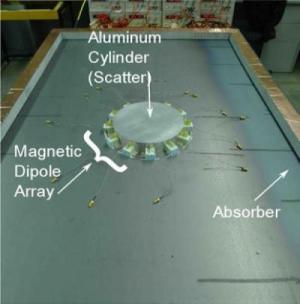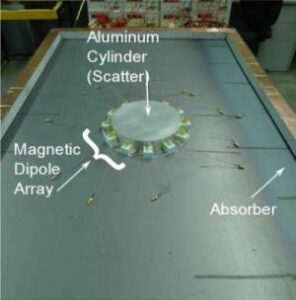Invisibility cloaking is no longer the stuff of science fiction:
Two researchers in The Edward S. Rogers Sr. Department of Electrical & Computer Engineering have demonstrated an effective invisibility cloak that is thin, scalable and adaptive to different types and sizes of objects.
Professor George Eleftheriades and PhD student Michael Selvanayagam have designed and tested a new approach to cloaking—by surrounding an object with small antennas that collectively radiate an electromagnetic field. The radiated field cancels out any waves scattering off the cloaked object. Their paper ‘Experimental demonstration of active electromagnetic cloaking’ appears today in the journal Physical Review X.
“We’ve taken an electrical engineering approach, but that’s what we are excited about,” says Eleftheriades. “It’s very practical.”
Picture a mailbox sitting on the street. When light hits the mailbox and bounces back into your eyes, you see the mailbox. When radio waves hit the mailbox and bounce back to your radar detector, you detect the mailbox. Eleftheriades and Selvanyagam’s system wraps the mailbox in a layer of tiny antennas that radiate a field away from the box, cancelling out any waves that would bounce back. In this way, the mailbox becomes undetectable to radar.
“We’ve demonstrated a different way of doing it,” says Eleftheriades. “It’s very simple: instead of surrounding what you’re trying to cloak with a thick metamaterial shell, we surround it with one layer of tiny antennas, and this layer radiates back a field that cancels the reflections from the object.”
Their experimental demonstration effectively cloaked a metal cylinder from radio waves using one layer of loop antennas. The system can be scaled up to cloak larger objects using more loops, and Eleftheriades says the loops could become printed and flat, like a blanket or skin. Currently the antenna loops must be manually attuned to the electromagnetic frequency they need to cancel, but in future they could function both as sensors and active antennas, adjusting to different waves in real time, much like the technology behind noise-cancelling headphones.
Work on developing a functional invisibility cloak began around 2006, but early systems were necessarily large and clunky—if you wanted to cloak a car, for example, in practice you would have to completely envelop the vehicle in many layers of metamaterials in order to effectively “shield” it from electromagnetic radiation. The sheer size and inflexibility of the approach makes it impractical for real-world uses. Earlier attempts to make thin cloaks were not adaptive and active, and could work only for specific small objects.
Beyond obvious applications, such as hiding military vehicles or conducting surveillance operations, this cloaking technology could eliminate obstacles—for example, structures interrupting signals from cellular base stations could be cloaked to allow signals to pass by freely. The system can also alter the signature of a cloaked object, making it appear bigger, smaller, or even shifting it in space. And though their tests showed the cloaking system works with radio waves, re-tuning it to work with Terahertz (T-rays) or light waves could use the same principle as the necessary antenna technology matures.
Go deeper with Bing News on:
Invisibility cloak
- Scientists solved the 70-year-old mystery of an insect's invisibility coat that can manipulate light
We tend to think of invisibility cloaks as science fiction. But one group of scientists has taken a big step toward making them a reality. For the first time, scientists at Pennsylvania State ...
- MIT Technology Review
Precancerous colon cells turn on a gene that helps them evade the immune system until they develop into tumors. One of the immune system’s roles is to detect and kill cells that have acquired ...
- Realization of an ideal omnidirectional invisibility cloak in free space
A team led by Prof. Dexin Ye and Prof. Hongsheng Chen from Zhejiang University, and Prof. Yu Luo from Nanyang Technological University conducted research on the practical implementation of ...
- Invisibility Shield lets you vanish like magic
Have you ever wanted to have superpowers? Maybe you wanted immense strength like Superman or extreme speed like the Flash. Perhaps you’re a massive Harry Potter fan who wants to slink into the ...
- Realization of an ideal omnidirectional cloak in free space
The past decade has witnessed the rapid development of transformation optics, through which various novel optical devices such as invisibility cloaks, electromagnetic illusion devices and ...
Go deeper with Google Headlines on:
Invisibility cloak
[google_news title=”” keyword=”invisibility cloak” num_posts=”5″ blurb_length=”0″ show_thumb=”left”]
Go deeper with Bing News on:
Active invisibility cloak
- rochester cloak
Students at the University of Rochester have developed a clever optical system which allows for limited invisibility thanks to a bit of optic sorcery physics. Almost all invisibility technologies ...
- MIT Technology Review
This gene encodes a transcription factor that is normally active only during embryonic development, when it helps control development of the intestines and the formation of blood vessels.
- Realization of an ideal omnidirectional invisibility cloak in free space
A team led by Prof. Dexin Ye and Prof. Hongsheng Chen from Zhejiang University, and Prof. Yu Luo from Nanyang Technological University conducted research on the practical implementation of ...
- Startup Selling Invisibility Shields
Cloak Engaged Remember the Invisibility Shield that launched on Kickstarter just over two years ago? The British startup's eye-tricking gizmo, which is roughly as flat as a piece of cardboard, can ...
- Realization of an ideal omnidirectional cloak in free space
The past decade has witnessed the rapid development of transformation optics, through which various novel optical devices such as invisibility cloaks, electromagnetic illusion devices and ...
Go deeper with Google Headlines on:
Active invisibility cloak
[google_news title=”” keyword=”Active invisibility cloak” num_posts=”5″ blurb_length=”0″ show_thumb=”left”]












